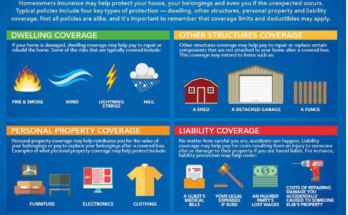Home Insurance Explained: Key Terms and Conditions You Should Know
Home insurance is a crucial aspect of homeownership that provides financial protection against potential risks. Understanding the key terms and conditions related to home insurance is essential for homeowners, prospective buyers, and renters alike. This comprehensive guide will delve into what home insurance is, how it works, its various features, pros and cons, alternatives, and more. By the end, you’ll be equipped with the knowledge to make informed decisions regarding home insurance.
What is Home Insurance Explained: Key Terms and Conditions You Should Know?
Home insurance, often referred to as homeowners insurance, is a type of property insurance that provides financial coverage for your home and personal belongings in case of damage or loss due to specific perils. These perils can include events such as fire, theft, vandalism, and natural disasters.
Key Terms:
- Premium: The amount you pay for your insurance policy, usually annually or monthly.
- Deductible: The out-of-pocket expense you pay before your insurance kicks in.
- Coverage Limit: The maximum amount your insurance will pay for a covered loss.
- Exclusions: Specific conditions or circumstances that are not covered by the policy.
- Riders/Endorsements: Additional coverage options that can be added to your policy for specific needs.
Understanding these terms is essential for navigating your policy effectively and ensuring you have adequate coverage.
How Home Insurance Explained: Key Terms and Conditions You Should Know? Work
Home insurance works by protecting your home and belongings against financial loss. Here’s a breakdown of how it operates:
- Policy Purchase: Homeowners select a policy that fits their needs and budget.
- Premium Payment: Insured individuals pay a premium based on the coverage amount, the location of the property, and other risk factors.
- Coverage Activation: Upon payment, the policy activates, providing coverage for specific risks outlined in the policy.
- Claim Process: In the event of damage or loss, homeowners file a claim. The insurance company assesses the damage and pays out based on the policy’s terms.
- Deductible Application: Homeowners must pay the deductible amount before receiving any insurance payout.
It’s important to read your policy carefully to understand the coverage limits, exclusions, and the process for filing claims.
Features of Home Insurance Explained: Key Terms and Conditions You Should Know?
Home insurance policies can vary widely in terms of features and coverage. Here are the key features typically found in home insurance policies:
- Dwelling Coverage: Protects the structure of your home, including walls, roof, and built-in appliances.
- Personal Property Coverage: Covers your belongings, such as furniture, electronics, and clothing, in case of theft or damage.
- Liability Coverage: Offers protection if someone gets injured on your property, covering legal fees and damages.
- Loss of Use Coverage: Provides financial support for living expenses if you cannot stay in your home due to a covered loss.
- Additional Structures Coverage: Protects structures not attached to your home, such as garages or sheds.
Comprehensive Detailing of Each Feature:
| Feature | Description |
|---|---|
| Dwelling Coverage | Covers physical damage to the home structure. |
| Personal Property Coverage | Covers personal belongings against loss or damage. |
| Liability Coverage | Protects against claims from injuries on your property. |
| Loss of Use Coverage | Provides funds for temporary housing while repairs are made. |
| Additional Structures Coverage | Insures separate buildings on your property. |
Understanding these features can help you tailor your policy to meet your specific needs.
Pros of Home Insurance Explained: Key Terms and Conditions You Should Know?
Home insurance offers several benefits that can provide peace of mind and financial security.
| Pros | Description |
|---|---|
| Financial Protection | Safeguards against significant financial loss. |
| Peace of Mind | Reduces stress by knowing your home is protected. |
| Liability Coverage | Protects against potential lawsuits from injuries. |
| Additional Living Expenses | Covers costs if you need temporary housing. |
| Customization | Options to tailor coverage to your needs. |
Home insurance is not just a policy; it’s an investment in your security and peace of mind.
Cons of Home Insurance Explained: Key Terms and Conditions You Should Know?
While home insurance is essential, there are also some drawbacks to consider.
| Cons | Description |
|---|---|
| Cost | Premiums can be expensive, especially in high-risk areas. |
| Exclusions | Certain disasters, like floods or earthquakes, may not be covered. |
| Complexity | Policies can be complicated to understand fully. |
| Deductibles | Out-of-pocket expenses can be high during a claim. |
| Policy Limits | Coverage limits may not fully cover total losses. |
Understanding these cons can help you weigh the value of having home insurance against its costs.
Home Insurance Explained: Key Terms and Conditions You Should Know? Alternatives
For those seeking alternatives to traditional home insurance, there are options available.
| Alternatives | Description |
|---|---|
| Renters Insurance | For tenants; covers personal belongings and liability. |
| Landlord Insurance | Designed for rental property owners, covering loss of rental income. |
| Home Warranty | Covers repairs and replacements of home systems and appliances. |
| Bundled Insurance Policies | Combining auto, health, and home insurance for potential discounts. |
Exploring these alternatives can help you find the right coverage for your needs.
Conclusion and Verdict: Home Insurance Explained: Key Terms and Conditions You Should Know?
Understanding home insurance is vital for homeowners. Knowing the key terms and conditions helps you make informed decisions, ensuring adequate coverage for your property and belongings. While there are pros and cons associated with home insurance, the financial protection it offers is invaluable. By assessing your needs, comparing policies, and understanding the nuances of home insurance, you can secure peace of mind in your homeownership journey.
FAQs: Home Insurance Explained: Key Terms and Conditions You Should Know?
- What is the average cost of home insurance?
- The average cost can vary significantly based on factors like location and property value, but it typically ranges from $800 to $1,500 annually.
- Can I change my coverage after purchasing a policy?
- Yes, you can adjust your coverage as needed, but it may affect your premium.
- What should I do if my claim is denied?
- Review the denial reason, contact your insurer for clarification, and consider filing an appeal if you believe it’s unjust.
- How often should I review my home insurance policy?
- It’s recommended to review your policy annually or whenever significant changes occur in your life or property.
- Is home insurance required for renters?
- While not legally required, renters insurance is highly advisable to protect personal belongings and liability.
By following the guidelines provided in this review, homeowners can better navigate the complexities of home insurance, ensuring they have the right protection for their most valuable asset.



